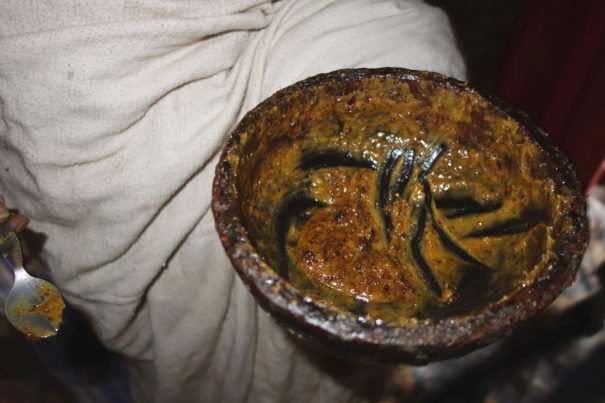
Deliciously Complex, With a Hint of Dead Baby Bee

Deliciously Complex, With a Hint of Dead Baby Bee
Honey in Ethiopia
The town of Lalibela in Ethiopia is famous for its World Heritage-listed, rock-hewn churches. It’s named after King Lalibela, whose visions of a New Jerusalem inspired him to commission the churches during the 12th and 13th centuries. When King Lalibela was born he was swarmed by bees, which is why his name translates as: “the bees recognize his sovereignty.” It’s only fitting, then, that the region takes pride in its honey.
Bilbila Giyorgis is another rock-hewn church a few valleys away from Lalibela. The semi-monolithic church is much older and less-ornate than the ones at Lalibela. Constructed around the 5th century, its façade isn’t intricate and it lacks interior decorations. A single, crude painting of St. George’s horse lies where other churches have vivid frescos. But also unlike the churches at Lalibela, Bilbila Giyrogis has the bees.
Much like King Lalibela’s auspicious birth, five swarms of bees settled inside Bilbila Giyorgis shortly after it was built. The same colony of bees that took up residency in the church’s rocky crevices has been tended to by successive generations of priests to the present day. Their work has become a labour of love, and their technique has been perfected to an art form, as you’d expect for a tradition spanning millennia. The hives are hard to see, and my eye struggled to adjust from the glare outside to the church’s dim interior. Instead, they were given away by their steady hum, the sound of bees at work.
The honey is only collected annually, around Ethiopian New Year, which falls on September 11 or 12. It’s appreciated by the community for its medicinal value, owing to the hive’s location in a church. These healing powers are said to apply to skin, abdominal, and psychological conditions.
I wasn’t seeking any antidotes for these ailments, but the priest was still kind enough to give me a taste of the holy honey. Before even trying it, it was clear that this was not any ordinary honey—it was opaque, its texture was firm and it had all sorts of unusual shapes suspended in its fluid. The taste, similarly, was gritty, floral, and totally unique. While eating, I found myself spitting out beeswax, honeycomb, and dead baby bees. Perhaps I would need the honey’s curative properties after all. With the next mouthful, it tasted sweet but not sugary, and granular but not crunchy. It’s a flavor that can’t ever be forgotten: so distinct, powerful, and complex at the same time.
The honey is not refined in any way; it’s consumed unchanged from as it was in the hive, and unchanged from how it was collected 1,500 years ago.
It’s not perfect, but rather deliciously imperfect. The world’s best honey hasn’t been fine-tuned in a kitchen or lab—it’s collected by hand by priests in Ethiopia.